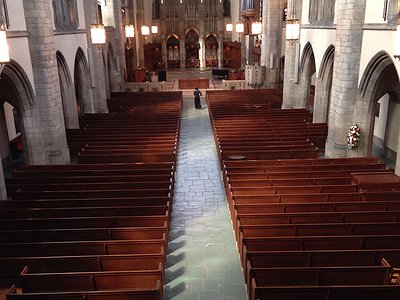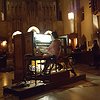Could you take us through a day in your life, from a possible morning routine through to your work? Do you have a fixed schedule? How do music and other aspects of your life feed back into each other - do you separate them or instead try to make them blend seamlessly?
My daily routine depends on which phase of my work I am in. If I am not doing an installation somewhere, touring or doing a teaching residency out of town, then I am at home in Chicago working.
I’m not a morning person, but I try and get up early when I can. I sometimes make coffee, and sometimes work at a café near my home in the morning. Much of my workday consists of emailing, writing descriptions, doing interviews, and grant or descriptive proposals for current or future projects. Correspondence and travel planning make up a large part of my job now.
I try to get those things out of the way first during the day, then dive into whatever studio project I am working on in the afternoon and evening. If I have a deadline, or really want to finish a studio piece, I stay up really late for many days in a row. I don’t necessarily have a set schedule when I am home. I try to have some flexibility and if I am not “feeling it” I don’t push myself to work on a project, because it becomes counter productive. Plus, I teach in a couple of places, so that always thwarts any attempts at regular scheduling.
Could you describe your creative process on the basis of a piece or album that's particularly dear to you, please? Where did the ideas come from, how were they transformed in your mind, what did you start with and how do you refine these beginnings into the finished work of art?
I think Heave To (Sedimental, 2005) was a turning point for me. I learned how to created a dense musical collage including and combining many disparate types of sounds and felt like a really sculpted the materials. Before I started that project, I remember listening to the wind and watching leaves on a tree move in response to that wind. One leaf would move, then another, then all of them.
I asked myself, how does that complex and subtle pattern of movement form? How can I translate that into a musical composition? I wanted to make a piece that moved like a weather pattern.
At the same time, I was interested in orchestral music, but wanted to figure out how to free traditional instrumental sounds from their conventional associations and from the listener’s cognitive hierarchies. In other words, I wanted to try and compose a piece including violin sounds, but arranged so that those violin sounds would not take over the attention of the listener when they were present.
Thematically, I was thinking about storms at sea, reading "Moby Dick", and thinking about larger issues like the history of colonialism via sea ports, and 21st century concerns related to climate change.
I started by recording real sea and wooden boat sounds from a few locations,then recording musicians in guided improvisations. I then shaped these materials--turning them over and over and recombining them until the artificial nature of the process resulted in a “natural” sense of sonic movement.
There are many descriptions of the ideal state of mind for being creative. What is it like for you? What supports this ideal state of mind and what are distractions? Are there strategies to enter into this state more easily?
I have been in so many states of mind and health over the last twenty-five years, that I actually think the best way for me to be an artist is to simply commit to the work no matter how I feel. I have a chronic health thing that sometimes causes really bad fatigue. When I have been sick or depressed in the past, I worked anyway. There were times that I could not get out of bed, but I could still work with a laptop. Otherwise, in general, I pay attention to my surroundings and let my curiosity lead my interests.
How is playing live and writing music in the studio connected? What do you achieve and draw from each experience personally? How do you see the relationship between improvisation and composition in this regard?
I conceive of these elements as stages in one larger process of creation.
A single piece might start with a series of studio sessions including myself and other musicians, improvising some loosely scripted ideas. The performed ideas that sounded successful might later become more formally scored, then recorded in the studio.
In the category of live performance the relationship between improvisation and composition is less complicated. If I perform solo, for instance, I use an outline and improvise to get from one section to the next.
How do you see the relationship between the 'sound' aspects of music and the 'composition' aspects? How do you work with sound and timbre to meet certain production ideas and in which way can certain sounds already take on compositional qualities?
I think a lot about the compromise that must be made between the tendency of the sounds and my “vision” of what the piece will sound like in the end. I notice that when I work on a studio composition, sound materials seem to “want” to go into certain combinations, at a certain pace, etc. So whatever conceptual or imagined idea I had going into the composition process always must be tempered and informed by the natural tendencies of those sonic materials.
Our sense of hearing shares intriguing connections to other senses. From your experience, what are some of the most inspiring overlaps between different senses - and what do they tell us about the way our senses work? What happens to sound at its outermost borders?
I love the idea of haptic and auditory senses being activated together, or being blurred to create perception. I am interested in studies that demonstrate how the feeling of a human speaker’s breath against the skin of a listener can affect how words are heard and interpreted.
Right now I am working on an idea for an installation with an architect. It (hopefully) will result in a large structure of tall grass standing in a windy area. I love the idea of hearing and feeling the wind together.
Art can be a purpose in its own right, but it can also directly feed back into everyday life, take on a social and political role and lead to more engagement. Can you describe your approach to art and being an artist?
My approach is always changing, but right now, I am interested in facilitating situations through installation or performances, where the audience has an interactive experience with other people, (in some cases non-human animals) and/or the surroundings that is not based around language, personal/social media and/or technological devices.
This approach informed the original performance of 132 Ranks. I wanted to open up the Rockefeller Chapel so that the audience could walk around and explore the inside of the building while I performed the piece on the organ. My performance, visually, was not the focus of the event. Rather, for the audience, the experience of moving through the building and listening to how the built materials affected the organ sounds became the emphasis.
I want to remind people of their physical existence and limitations in the physical world and to encourage communications with others in person. I am also interested in working with non-human animals, or facilitating situations in which humans might become more aware of other animals in different ways.
It is remarkable, in a way, that we have arrived in the 21st century with the basic concept of music still intact. Do you have a vision of music, an idea of what music could be beyond its current form?
I have no visions or definitions. I am trying to stay open and go with the flow right now.



